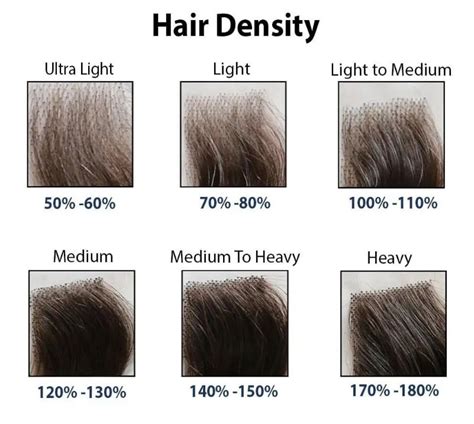Introduction
Hair replacements are a transformative solution for addressing hair loss and achieving a desired look. Two popular options are 260 density and 180 density hairpieces. Both offer unique advantages and cater to specific preferences. This comprehensive guide will delve into the intricate details of these densities, helping you make an informed decision.

Key Differences:
Density
- 260 Density Hairpiece: Features 260 individual hairs per square inch, providing a thick and lush appearance.
- 180 Density Hairpiece: Includes 180 individual hairs per square inch, offering a more natural and blended look.
Volume and Bulk
- 260 Density Hairpiece: Creates a noticeably voluminous and dramatic effect.
- 180 Density Hairpiece: Provides moderate volume, enhancing the natural density without creating an excessive or unnatural appearance.
Advantages and Disadvantages:
260 Density Hairpiece:
-
Advantages:
- Creates a full, luxurious, and impressive look.
- Ideal for individuals who desire a dramatic transformation.
- Can help conceal thinning areas effectively.
-
Disadvantages:
- May require more rigorous maintenance and styling to prevent matting.
- Can feel heavier and less comfortable due to the sheer number of hairs.
180 Density Hairpiece:
-
Advantages:
- Offers a natural and seamless blend with the recipient’s own hair.
- Less prone to tangling and easy to maintain.
- Comfortable to wear for extended periods.
-
Disadvantages:
- May not provide as much coverage as a 260 density hairpiece.
- Might not create a sufficiently dramatic effect for some individuals.
Suitability:
- 260 Density Hairpiece: Ideal for individuals with significant hair loss or baldness, seeking a bold and dramatic transformation.
- 180 Density Hairpiece: Suitable for those with moderate hair loss or thinning areas, preferring a subtle and realistic appearance.
Maintenance and Styling:
-
260 Density Hairpiece: Requires regular brushing, detangling, and styling to maintain its volume and prevent matting.
- Use wide-toothed combs and gentle shampoos specifically designed for hair extensions.
- Avoid excessive heat styling to prevent damage.
-
180 Density Hairpiece: Easier to maintain, requiring less brushing and styling.
- Can use regular shampoos and conditioners, as long as they are sulfate-free.
- Low-heat styling is recommended to maintain the natural texture.
Cost Comparison:
Generally, 260 density hairpieces are priced higher than 180 density hairpieces due to the increased number of hairs used. The exact cost can vary depending on the hair quality, length, and style.
Research and Statistics:
According to the American Hair Loss Association, an estimated 50 million men and 30 million women experience significant hair loss in the United States alone.
A study conducted by the International Society of Hair Restoration Surgeons found that over 70% of individuals with hair loss prefer hair replacements with a density between 180 and 260 hairs per square inch.
Motivation and Pain Points:
-
Motivation for Choosing a Hairpiece:
- Regain confidence and self-esteem.
- Address social stigma and improve overall well-being.
- Enhance personal and professional appearance.
-
Pain Points to Consider:
- Cost and investment associated with hair replacement.
- Maintenance and styling requirements.
- Potential for discomfort or sensitivities.
Common Mistakes to Avoid:
- Choosing a hairpiece that is too dense or too thin for your desired look.
- Using harsh chemicals or heat styling techniques that can damage the hair.
- Over-washing the hairpiece, which can strip it of its natural oils.
- Ignoring professional consultations and attempting self-installation or maintenance.
Frequently Asked Questions (FAQs):
- Which density is better for a natural look? 180 density
- Which density is easier to maintain? 180 density
- Can I swim or exercise with a hairpiece? Yes, with proper precautions and swimming caps.
- How often should I get my hairpiece professionally maintained? Every 4-8 weeks
- Can I cut or style a hairpiece? Yes, but it’s recommended to consult a professional.
- How long will a hairpiece last? 6-18 months with proper care
Conclusion:
Choosing between 260 density and 180 density hairpieces ultimately depends on individual preferences and desired outcomes. 260 density hairpieces provide maximum volume and coverage, while 180 density hairpieces offer a more natural and blended appearance. By carefully considering the key differences, advantages, and disadvantages discussed in this article, you can make an informed decision that will enhance your appearance and boost your confidence. Embrace the power of hair replacements to transform your life today!
Table 1: Density Comparison
| Density | Number of Hairs | Volume |
|---|---|---|
| 260 Density | 260 per square inch | High |
| 180 Density | 180 per square inch | Moderate |
Table 2: Advantages and Disadvantages Comparison
| Density | Advantages | Disadvantages |
|---|---|---|
| 260 Density | – Full and luxurious appearance | – Requires more rigorous maintenance |
| – Ideal for concealing thinning areas | – Can feel heavier and less comfortable | |
| 180 Density | – Natural and seamless blend | – May not provide as much coverage |
| – Easy to maintain | – Might not create a sufficiently dramatic effect for some individuals |
Table 3: Suitability Comparison
| Density | Suitable for |
|---|---|
| 260 Density | – Individuals with significant hair loss or baldness |
| 180 Density | – Those with moderate hair loss or thinning areas |
Table 4: Cost Comparison
| Density | Average Cost Range |
|---|---|
| 260 Density | $1,200 – $2,500 |
| 180 Density | $800 – $1,800 |
